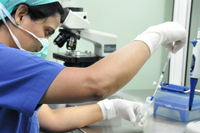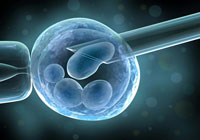-
 INTRAUTERINE INSEMINATION
INTRAUTERINE INSEMINATION
IUI stands for intrauterine insemination and involves depositing sperm into a woman's uterus in the hopes of facilitating conception. It is the commonest used method of artificial insemination. It is a simple and safe treatment modality in infertility aimed at overcoming the natural barriers to the passage of the sperms from the vagina to the fallopian tubes. During IUI, a prepared semen sample with adequate numbers of motile, normal sperms suspended in a nutrient medium are directly placed in the uterine cavity, thus bypassing the need for sperms to travel from the vagina to the uterus. This is done around the predicted time of ovulation.
Indications for IUI IUI is advised for certain indications

Impaired semen quality, where the semen sample has low counts or motility 
Sexual problems in the male like impotence or premature ejaculation 
Conditions where the cervix is hostile and thereby destroys the sperms, as evidenced by certain tests 
Unexplained infertility where all tests for infertility in the male and female are normal, yet the woman is unable to conceive. The initial work - up
A comprehensive history is taken and the reqired investigations are performed. Prior to undertaking treatment with IUI certain things need to be ensured.

The ovary contains healthy oocytes or eggs. 
The fallopian tubes are patent or open. At least one tube has to be open in order to perform an IUI. 
The uterus is normal. 
The semen sample contains sufficient numbers of motile, normal sperms. 
In the event that a donor semen sample is used investigations are carried out to ensure that the donor is free of infectious diseases. -

STEPS INVOLVED IN ONE COMPLETE IUI CYCLE  Ovulation InductionIUI is performed at the time of ovulation in a natural menstrual cycle or in a cycle where the ovaries have been stimulated by certain drugs. Ovulation induction or stimulation of the ovaries, is the administration of certain drugs which act on the ovaries and stimulate them to produce more eggs, thus improving the chances of conception. The woman is asked to attend the clinic on the 2nd day of her menstrual cycle. After an ultrasound examination to check her uterus and ovaries she is prescribed medication to stimulate her ovaries. Such drugs are administered to ensure that the ovaries produce more than one egg to improve chances of conceptions. These can be in the form of oral medication or as injections which may have to be taken daily or on alternate days.
Ovulation InductionIUI is performed at the time of ovulation in a natural menstrual cycle or in a cycle where the ovaries have been stimulated by certain drugs. Ovulation induction or stimulation of the ovaries, is the administration of certain drugs which act on the ovaries and stimulate them to produce more eggs, thus improving the chances of conception. The woman is asked to attend the clinic on the 2nd day of her menstrual cycle. After an ultrasound examination to check her uterus and ovaries she is prescribed medication to stimulate her ovaries. Such drugs are administered to ensure that the ovaries produce more than one egg to improve chances of conceptions. These can be in the form of oral medication or as injections which may have to be taken daily or on alternate days. Monitoring the CycleA very important part of the IUI treatment cycle is making sure that the insemination is done at the time of ovulation. In order to ensure this and to monitor that the ovary is responding well to the given drugs an ultrasound scan is performed usually on the 8th or 9th day of the cycle after the day 2 scan . Depending on the growth of the follicles (structures in the ovary containing the eggs) the scans are repeated till the right size is reached . The woman may then be advised to take an injection to help release the egg from the follicle or one can wait for it to get released on its own. At the predicted time of ovulation intrauterine insemination is carried out.
Monitoring the CycleA very important part of the IUI treatment cycle is making sure that the insemination is done at the time of ovulation. In order to ensure this and to monitor that the ovary is responding well to the given drugs an ultrasound scan is performed usually on the 8th or 9th day of the cycle after the day 2 scan . Depending on the growth of the follicles (structures in the ovary containing the eggs) the scans are repeated till the right size is reached . The woman may then be advised to take an injection to help release the egg from the follicle or one can wait for it to get released on its own. At the predicted time of ovulation intrauterine insemination is carried out. When is the best timing for IUI ?In general, it is usually recommended to do IUI just before ovulation is set to take place. Six hours is often the time frame given as washed sperm doesn't live much beyond six to 12 hours. Cycles using a single IUI are normally done 36 hours after the surge is detected or 36 hours after an hCG injection when a trigger for ovulation is given, while those having two IUIs done will be inseminated between 24 and 48 hours after the surge/hcg injection. There may be a slightly increased chance of pregnancy with two IUIs, but the difference is not statistically significant.
When is the best timing for IUI ?In general, it is usually recommended to do IUI just before ovulation is set to take place. Six hours is often the time frame given as washed sperm doesn't live much beyond six to 12 hours. Cycles using a single IUI are normally done 36 hours after the surge is detected or 36 hours after an hCG injection when a trigger for ovulation is given, while those having two IUIs done will be inseminated between 24 and 48 hours after the surge/hcg injection. There may be a slightly increased chance of pregnancy with two IUIs, but the difference is not statistically significant.
 Semen CollectionAbstinence is to be observed 2-4 days prior to the procedure. On the day of the insemination the husband gives a semen sample in a wide-mouthed sterile container provided by the Clinic. The sample should be obtained by masturbation and not coitus interuptus. Semen can be collected either at home, if you live close to the centre, or at IVF-Pune unit itself. Facilities ensuring privacy are available at the Clinic for this purpose. If you plan on collecting the semen sample at home , then this sample needs to be delivered to the clinic within an half hour of ejaculation. This is when a fresh sample is being used to perform the IUI . In case the husband cannot be present around the time of ovulation a sample can be frozen and frozen sperms can also be used to perform IUI. When donor semen samples are used , these are always frozen samples.
Semen CollectionAbstinence is to be observed 2-4 days prior to the procedure. On the day of the insemination the husband gives a semen sample in a wide-mouthed sterile container provided by the Clinic. The sample should be obtained by masturbation and not coitus interuptus. Semen can be collected either at home, if you live close to the centre, or at IVF-Pune unit itself. Facilities ensuring privacy are available at the Clinic for this purpose. If you plan on collecting the semen sample at home , then this sample needs to be delivered to the clinic within an half hour of ejaculation. This is when a fresh sample is being used to perform the IUI . In case the husband cannot be present around the time of ovulation a sample can be frozen and frozen sperms can also be used to perform IUI. When donor semen samples are used , these are always frozen samples.
After the specimen has been given for processing, the couple can leave and return for the insemination 1 -2 hours later as it would take this time approximately to prepare the sample. Preparation of the Semen Sample
Preparation of the Semen Sample Sperm washing must occur before IUI can happen. There are various ways in which sperm is prepared prior to IUI. The decision about which method of preparation is to be done is taken based on the quality of the semen sample as regards the volume, count and motility of the sperms. This process of sperm preparation can take anywhere from 45 minutes with simple sperm wash to one and a half hours with the swim up technique. Preparing the sample, in essence, refines and concentrates the sperms and enhances the fertilizing capacity of the semen specimen. Only motile normal sperms are obtained thereby eliminating all other contents. The sperms are suspended in a nutrient medium and this sample is used for insemination. Insemination should occur shortly after the sperm has been prepared.
Sperm washing must occur before IUI can happen. There are various ways in which sperm is prepared prior to IUI. The decision about which method of preparation is to be done is taken based on the quality of the semen sample as regards the volume, count and motility of the sperms. This process of sperm preparation can take anywhere from 45 minutes with simple sperm wash to one and a half hours with the swim up technique. Preparing the sample, in essence, refines and concentrates the sperms and enhances the fertilizing capacity of the semen specimen. Only motile normal sperms are obtained thereby eliminating all other contents. The sperms are suspended in a nutrient medium and this sample is used for insemination. Insemination should occur shortly after the sperm has been prepared.The Insemination Procedure 
IUI is a relatively simple and straight forward technique performed transvaginally as an outpatient procedure. It is performed by threading a very thin flexible catheter through the cervix and injecting washed sperm directly into the uterus. 
The woman is asked to pass urine so that her bladder is empty. 
The woman lies on a couch or bed with her legs raised. 
A speculum is inserted into the vagina so that the cervix which is the mouth of the uterus is visualized . Sometimes the anterior lip of the cervix is held with a forceps. These procedures may be a little uncomfortable but do not cause pain to the woman. Some women have likened it to a Pap smear in terms of discomfort. 
The IUI catheter with the processed semen sample is gently introduced into the uterus. 
The processed semen is injected slowly into the uterus over 30-60 seconds. 
The woman is asked to continue lying down for the next 30 minutes. 
She is then allowed to leave and can resume her routine activities immediately on return. -

DO'S AND DON'TS AFTER IUI

Though the cervix will close after the IUI, keeping the newly deposited sperm right where it should be, we encourage you to continue lying down for 20-30 minutes post the IUI procedure. Feel free to get up and move about after that as like mentioned above the sperms will remain right in place. 
There is no restriction in activity. There is no need for bed rest, diet and travel restrictions. 
The couple may continue to have sex if they desire after the insemination procedure is over. Infact it may aid conception. 
You can take a pain killer like buscopan which we will prescribe in case you are experiencing any pain or cramps after the procedure, but avoid NSAIDs, such as ibuprofen. 
After IUI the woman will be asked to take some medications which help provide hormonal support and implantation of the embryo. These can be in the form of oral medications or suppositories (medications to be inserted in the vagina). Make sure to take these as advised. -

INTERPRETING THE RESULT
It is best to wait for two weeks after the insemination procedure prior to testing for a pregnancy. One can also wait for 3-4 days over the expected date of the next menses before doing so. A pregnancy test can be done at home with urinary pregnancy testing kits, which are freely available. One can also come to the clinic if they wish so to get it tested. If a pregnancy is confirmed you will have to come for an ultrasound scan to confirm the site of pregnancy, viability and gestational age. You will have to continue the prescribed medication if you conceive.
In case you get your periods you can stop all medication and see the doctor on the second or third day of your menstrual cycle.

SUCCESS RATES
The success rates of IUI depends on a number of factors. IUIs done with fertility drugs that produce multiple eggs have higher success rates compared to natural cycle IUI. Additionally, sperm count greatly affects the outcome with IUI. Using sperm samples with a smaller count often cause a couple to have less success. Overall, though, a success rate of 12-15% with each IUI cycle can be expected. Cumulative success rate in 4 - 6 iu cycles is about 20 - 35 %.
Like IVF, a few cycles of IUI may be necessary before you are successful. Generally no more than 4-6 cycles of IUI are tried. If you fail to have any results after trying a few cycles with both oral and injectable fertility drugs, you may want to consider trying IVF.
-

SIDE EFFECTS
IUI is one of the least stressful fertility treatments on a woman's body.
Side effects are extremely rare and may include : 
Uterine cramps in about 5% of patients 
Spotting in about 1% 
Gastro intestinal upsets or nausea in about 0.05% of patients. 
There is also a risk of infection. However sterile conditions ensure that infection very rarely occurs.
Antibiotics are usually not necessary for the woman or her partner either before or after the procedure.
Women using fertility drugs have a risk of multiple pregnancy, which are particular to the drug they are receiving.
However with proper and regular monitoring, these risks should be minimized
When doing donor insemination adequate care is taken to ensure that the donor is free of infectious diseases. This is some background information on intrauterine insemination and we hope you find this informative. If you have any further queries please approach the front desk to schedule an appointment with one of our doctors.
We would be happy to be of assistance.


 |
| Get in Touch : Deenanath Mangeshkar Hospital & Research Center Erandawane, Pune 411 004. | ||
| Email : ivf@dmhospital.org | Phone : 020 - 49153347 / 020 - 49153396 | |

